The Surface 3 Review
by Brett Howse on May 4, 2015 9:00 AM ESTSystem Performance
Since the Surface 3 is a tablet that can replace your laptop, comparisons will be made between both devices. Because the new tablet is running full Windows 8.1 x64, it is possible to run the full benchmark suite that we have for laptops. On the tablet side, there are not a lot of cross-platform benchmarks so the only thing that can really be used is browser based tests. It is not ideal, but we have to work with what we have.
To summarize the Surface 3, it is powered by the top model of the latest Intel Atom 14nm stack. The Atom x7-Z8700 is a quad-core processor with a base frequency of 1.6 GHz. The CPU can turbo up to a maximum of 2.4 GHz, and all of this is done within a 2 watt Scenario Design Power. The review unit that I received is the $499 unit, so it only has 2 GB of LPDDR3 memory rather than the 4 GB offered on the higher priced model.
For comparisons against tablets, I have selected a sampling of several devices that have already been reviewed. Some of the devices are running on ARM processors, and several of the Windows ones run on Intel Core M, with a few more running on previous Atom architectures. To compare this device against any other device we have tested, please check out our Mobile Bench.
Tablet Performance
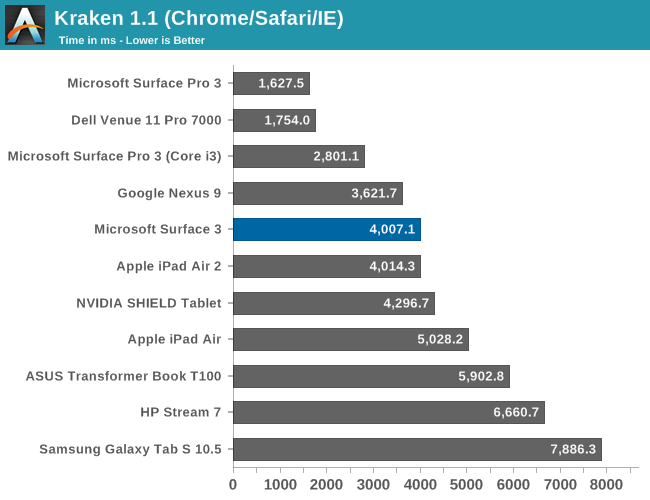
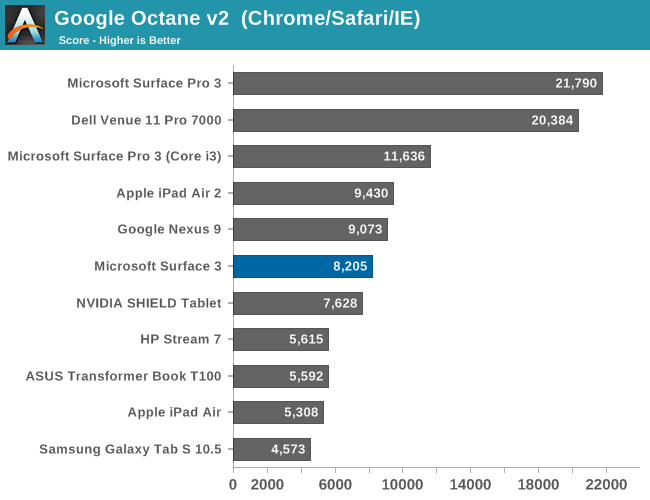
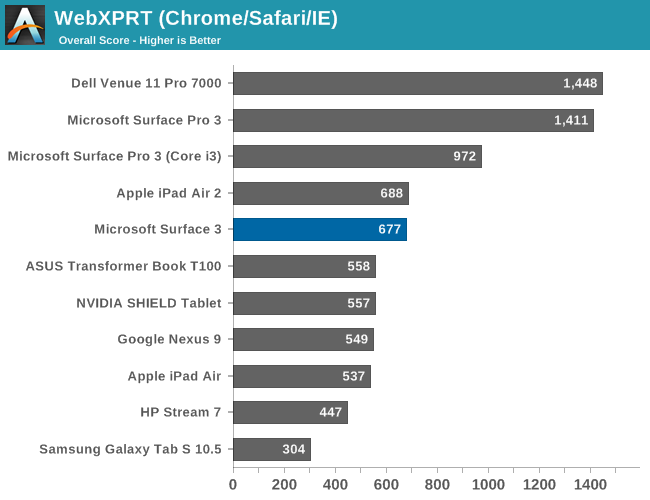
Since we just have web benchmarks to compare against other platforms, it does make it difficult to get a true feel for how Atom compares to the best, but when comparing to ARM processors it is fairly competitive. All of the web benchmarks are done using Chrome (hopefully we can switch to Microsoft Edge soon) because IE 11 has pretty awful javascript performance. Atom is a long ways off of the Core series in the Surface Pro line, and well back of the Core M powered Dell Venue 11 Pro tablet. There is a big jump in performance compared to the Bay Trail ASUS T100 and HP Stream 7. That is important since Cherry Trail is not a big architecture update, but mostly a process shrink, so the 14 nm processes can keep everything running at higher frequencies in the same power envelope.
Laptop Performance
By attaching the keyboard, the Surface 3 becomes a pretty reasonable laptop, so to see how much of a performance drop off there is with tablet class parts, the Surface 3 was run through our Laptop suite as well. The Atom is also equipped with eMMC storage, and some of the tests like PCMark take storage into account. Other benchmarks like Cinebench and x264 are CPU only. To compare the Surface 3 against any other laptop we have tested, please use our Laptop Bench.
PCMark
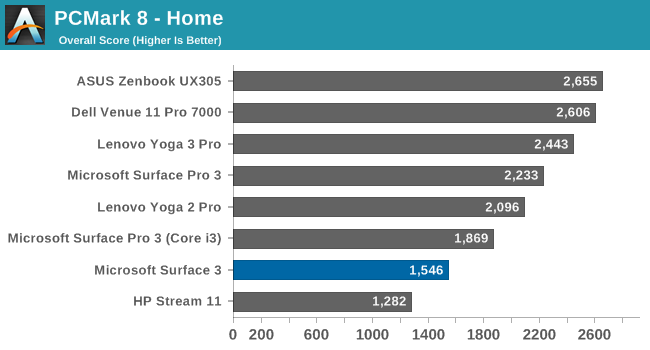
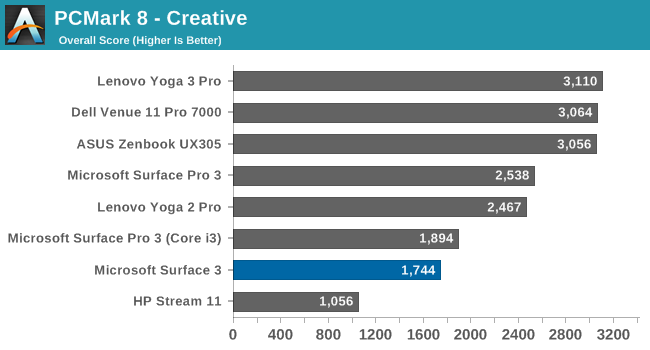
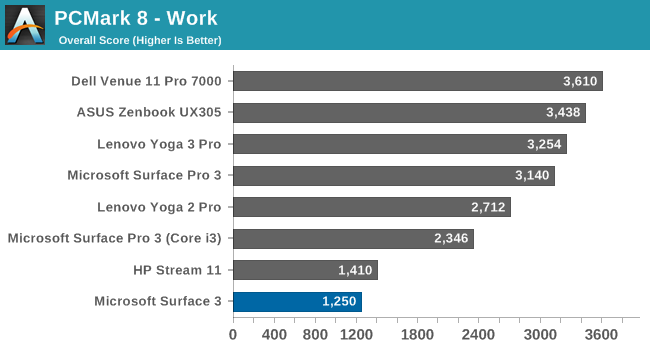
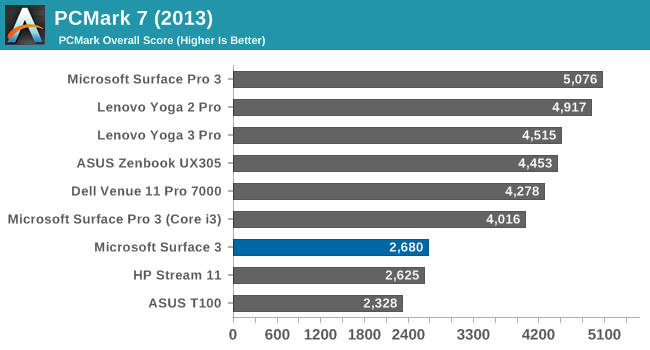
PCMark 8 from Futuremark has several benchmarks within it, all with the goal of simulating real-world use cases for each of the scenarios. It includes Home, Creative, Work, and Storage benchmarks. The workloads generally include both burst and sustained performance. The Atom can’t compete with the bigger Core pieces, but it is actually surprisingly close to the Core i3 Surface Pro 3. I think this is less about Atom and more about how handicapped Core i3 is with its lack of Turbo.
TouchXPRT
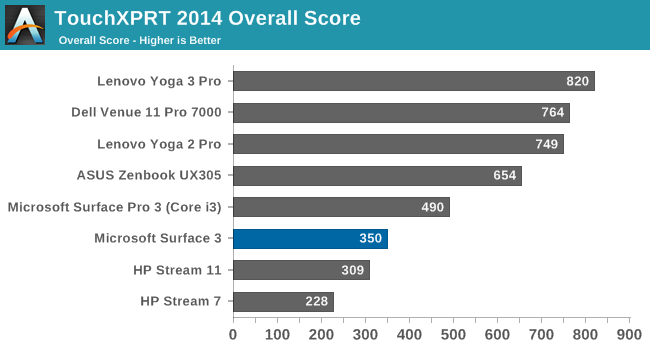
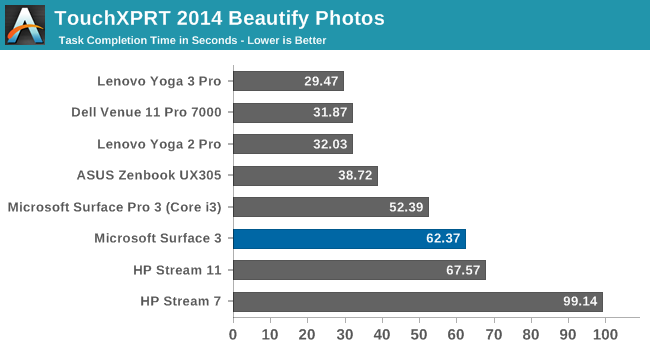
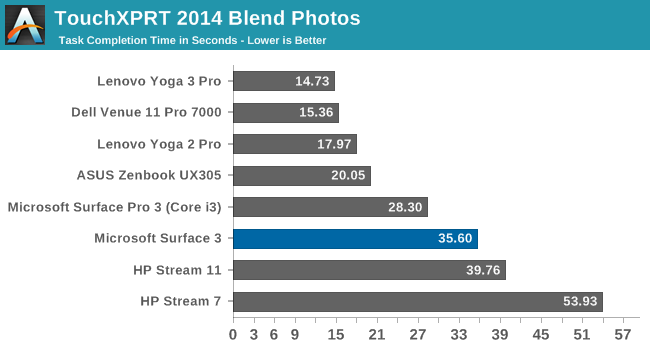
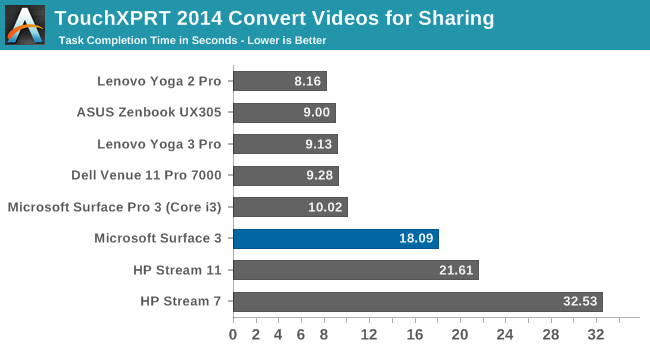
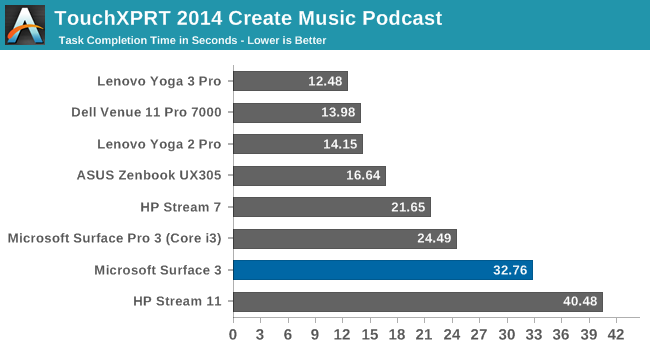
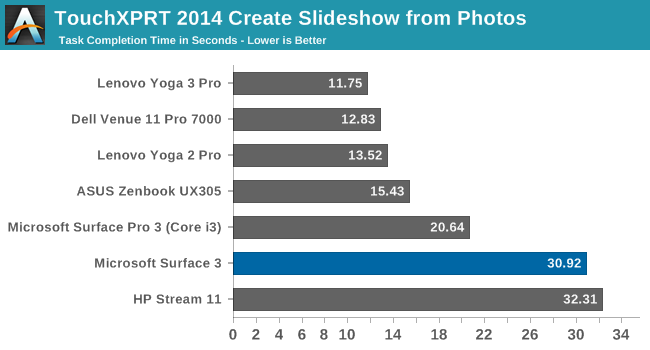
TouchXPRT 2014 is a benchmark that has a lot of burst workloads. The tasks are quick, but heavy, and it gives the processor a quick chance to cool off between each one so normally it is good about not running into throttling behaviour. The Atom processor is a long way off of the Core series here, with the exception of the i3 Surface Pro 3 which has no turbo capability. However there is a good bump in performance over the previous generation Atom in the HP Stream 7.
Cinebench
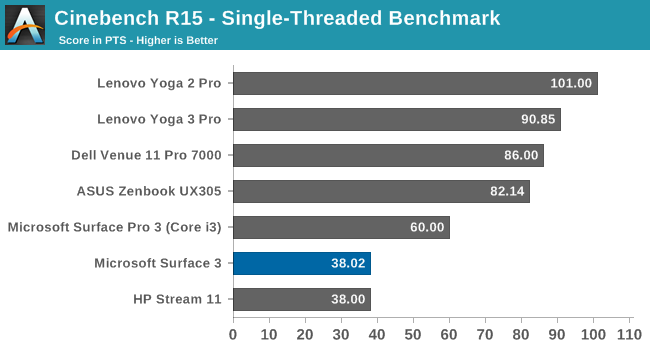
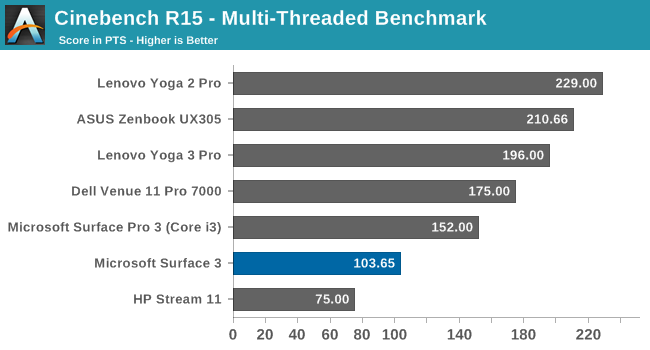
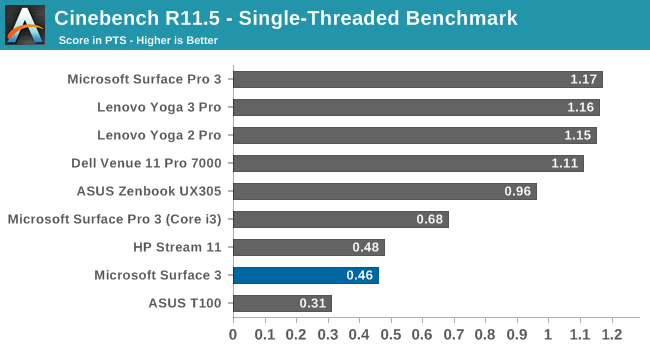
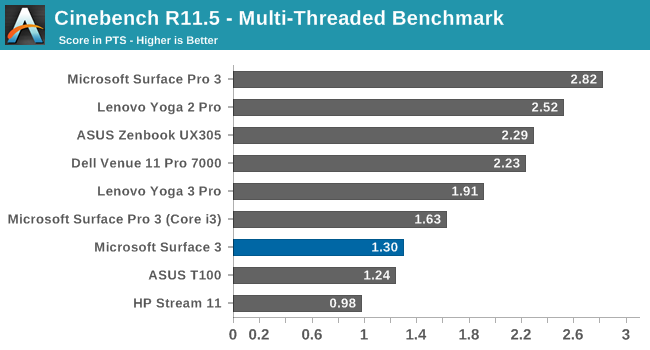
Cinebench is purely a CPU task, and it loves Instructions Per Clock (IPC) and frequency. There are two modes here with a single CPU run and all core run. It is still a long ways back of the Core i3 Surface Pro 3 on this test, and despite the Atom processor having four physical cores and the Core processors having only two physical and four logical cores, it is still not enough on the multithreaded run to really close the gap, although it does slightly. Looking at version 11.5 of this test, we have more data going back to older devices, so there are scores available from the ASUS T100 and there is a bump in performance compared to Bay Trail.
x264
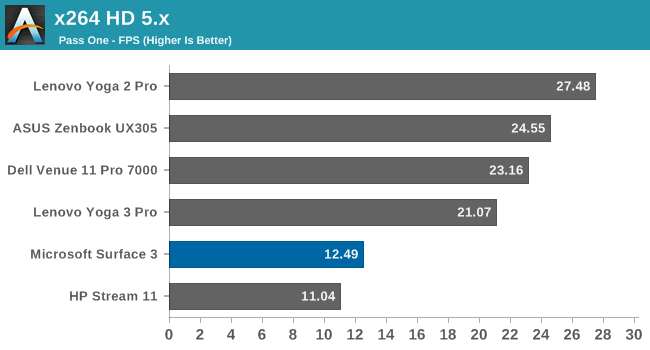
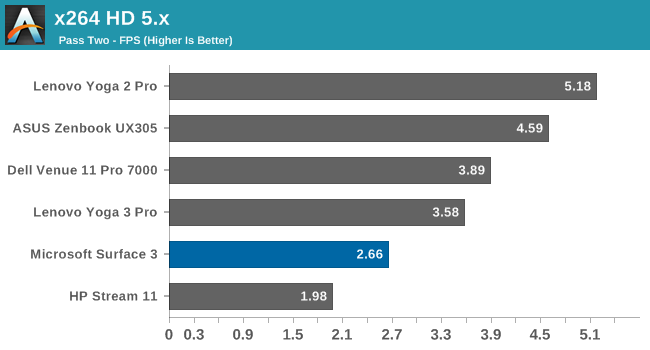
Once again this is a benchmark that prioritizes good IPC and frequency, along with multiple cores. The Atom struggles here compared to Core, which at this point should not be a surprise.
So clearly the new Cherry Trail CPU cores are not a giant leap in performance over Bay Trail, but like Haswell to Broadwell, there is a decent bump and the better manufacturing process helps increase overall performance due to the additional thermal headroom in the same power envelope. However when comparing it to the ARM competition, we only have a few data points but it does seem to be about on par with the top ARM CPUs at this time. Comparing devices across different operating systems is always difficult though.
Using the device day to day as a tablet though, performance was good. Yes, it could be better, and devices that use Core M are going to be able to run circles around Atom, but at the cost of additional heat. One of the nicest surprises of using this tablet was that it just never got warm at all, and the same cannot be said of any of the passively cooled Core M devices. Sure, when running very heavy benchmark loads, there was a bit of heat on the back, but it was never much more than around 30°C or so.
My experience was that when the Surface 3 felt slow, it was often not CPU bound but disk bound.










265 Comments
View All Comments
Brett Howse - Tuesday, May 5, 2015 - link
Windows Video app is used, and the file properties are listed on the graph. Let me know if you need anything else.MarcSP - Thursday, May 7, 2015 - link
No, that will be all. Dismised. :PHe, he. Thank for your reply! :-)
dusk007 - Monday, May 4, 2015 - link
One would wish Intel would just license the Mali GPUs or PowerVR designs. Even with 14nm they cannot keep up with Nvidia, Apple or any of the faster Adreno or Mali 760 SoCs.Also there doesn't seem to be any improvements. Their GPU design is not very power efficient and seemingly not even die space efficient but there are no real noticeable improvements between Gen 7 and 8. They should just go back to licensing or just buy Imagination Technologies.
Drumsticks - Monday, May 4, 2015 - link
Correct me if I'm wrong but don't skylake rumors include huge GPU strides?A5 - Monday, May 4, 2015 - link
Big grain of salt on that. Similar rumors were around for Haswell and Broadwell, too.lilmoe - Monday, May 4, 2015 - link
You'd think they'd at least get the GPU at performance parity with AMD's APUs by now....meacupla - Monday, May 4, 2015 - link
I think intel GPU performance is better than AMD APUs. Intel's solution does hardware video playback without sucking down enormous amounts of power.I won't even go into gaming, since both solutions are, flat out, subpar for that.
anubis44 - Monday, May 4, 2015 - link
Utterly wrong. AMD's Radeon GPU technology in their APUs crushes Intel's fastest integrated graphics. No comparison. Don't even try.meacupla - Tuesday, May 5, 2015 - link
That's not what I'm saying. Please read.AMD is faster, but at the cost of power and efficiency. And it still won't give you a good gaming experience, because there's not enough of everything in APUs.
Intel is slower, but gets the job done with regards to video, there was no question of it being gaming capable in the first place.
lilmoe - Tuesday, May 5, 2015 - link
Efficiency isn't AMD's fault. Intel's had the process lead for more than 2 generations now and they're STILL not even close to AMD's GPU performance... We'll see how efficient Intel's GPU is when AMD goes 14nm....